Mechanical art in limited edition.
Press release
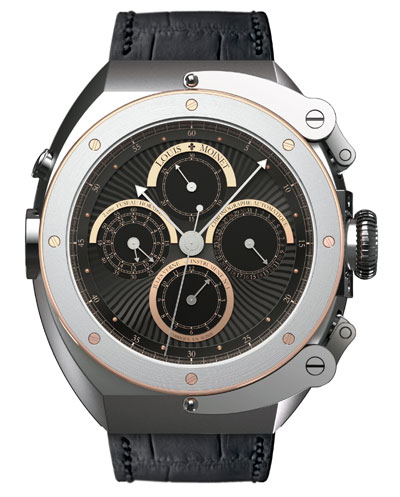
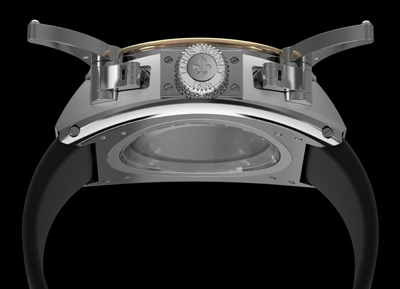
“From the Earth to the Moon”
JULES VERNE - Instrument 1
“Barbicane had set his chronometer to within a tenth of a second of engineer Murchison's; this latter was responsible for lighting the powder by means of an electric spark. By this means the travellers enclosed in the projectile could follow with their own eyes the impassive hand that would mark the exact moment of their departure”.
Jules Verne, From the Earth to the Moon
December 1
Having the exact time is absolutely essential to the success of this fantastic attempt. At exactly 10:46 and 40 seconds, the moon's zenith and perigee will simultaneously be ideal. “Thirty-five! Thirty-six! Thirty-seven! Thirty-eight! Thirty-nine! Forty! Fire !!”
A cone-nosed cylindrical shell bursts forth from the mouth of the Columbiad – the most fearsome cannon ever built – headed for the Moon! On board this space vessel is Impey Barbicane, President of the Baltimore Gun Club and leader of the mission. This “eminently serious and focused man”, “as accurate as a chronometer” is “adventurous, but brings practical ideas to even his rashest undertakings”. With him are Captain nicholl, his best enemy; and Michel Ardan, a capricious Parisian. These heroes do not return to earth until Around the Moon, in which their craft splashes down in the waters of the Pacifi c. This work, published in 1870, coincided with Charles Dowd's initial suggestion for dividing the united states into four time zones!
Patrick J. Gyger, Curator
Maison d'Ailleurs &
Espace Jules Verne
JULES VERNE - Instrument 1
An extraordinary instrument featuring two world firsts:An invention: a new way to use your chronograph. Louis Moinet has invented an advanced technical solution to start and stop the chronograph. This device off ers the advantage of fully securing the handling of the chronograph.
A real piece of the moon: following Magistralis and Datoscope, the Jules Verne line is the first limited edition in the world to use a real piece of the moon. This lunar meteorite is presented in a porthole at 9 o'clock.
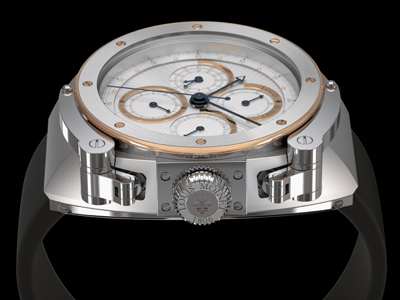
Movement: exclusive self-winding mechanical
Decoration: Blued steel screws, oscillating weight decorated with “Côtes du Jura” ® motif
Functions: Hour, minute and seconds
60-second chronograph (centre)
30-minute chronograph counter (at 12 o'clock)
12-hour chronograph counter (at 6 o'clock)
Date by hand (at 3 o'clock)
2nd time zone by hand (at 9 o'clock)
Jewels: 25
Winding: Automatic
Oscillations: 28,800 vph
Frequency: 4 Hz
Balance wheel: Glucydur type
Power reserve: 44 hours
Case: Hidden Secret no 3 Titanium Grade 5 & 316l
stainless steel & 18K rose gold 5n
The most useful properties of titanium are the corrosionresistance and lightness. Titanium is ca. 45% lighter than steel
Case diameter: 46.30 mm width x 54 mm length
Case thickness: 14.50 mm
Crown guard: Patent Pending
Water-resistance: 50 metres
Caseback secured with 4 screws, engraved with individual number and Louis Moinet emblems
Crystals: Two anti-glare sapphire crystals
Dial: Decorated with “Côtes du Jura” and applied half-circles
Hands: Rhodium-plated and galvanic blue
Strap: Crocodile leather, hand-sewn, “carbon” finish
Width: between lugs 24 mm
Buckle: 316l stainless steel folding clasp with louis Moinet symbol
Watch box: Louis Moinet Book in leather, hand-written warranty
Chronograph With 2nd Time Zone
“This firmament in which the stars move like the hands of a perfect clock that no jolt can disturb and boasting absolute exactitude; this firmament taught him all he needed to know about times and distances”
Jules Verne

“Around the Moon”
JULES VERNE - Instrument 2
“Nicholl's chronometer showed 10:20 p.m. when the three travellers shut themselves into their cannonball. It had been set to within a tenth of a second of engineer Murchison's. Barbicane consulted it. ‘My friends,' he said, ‘it is ten twenty. At ten forty-seven, Murchison will set off the electric spark on the wire that connects with the Columbiad's charge. At that exact moment, we will leave our spheroid. So we still have twenty-seven minutes on earth.' ‘Twenty-six minutes and thirteen seconds,' replied the methodical Nicholl”.
Jules Verne, Around the Moon
Accurate measurement of time was essential to these adventurers embarking on their trip Around the Moon, if they were even to attempt to achieve the aims of their spacefaring experience. so they were constantly checking their chronometers to calculate their speed and determine how much time they could still safely remain in their shell. For example, “On December 4, when the travellers awoke after fi fty-four hours of fl ight, the chronometers showed fi ve o'clock in the morning, earth time. Time-wise, they were only fi ve hours and forty minutes more than halfway through the time allowed for their stay in the projectile; but in terms of distance they had already completed nearly seven-tenths of the crossing...”
There is no doubt that a perfected measuring instrument was very useful for the calculations made by these heroes of Jules Verne – an author born in 1828, the year the fi rst split-second chronograph was patented !
Patrick J. Gyger, Curator
Maison d'Ailleurs &
Espace Jules Verne
JULES VERNE - Instrument 2
An extraordinary instrument featuring two world firsts :An invention : a new way to use your chronograph. louis Moinet has invented an advanced technical solution to start and stop the chronograph. This device off ers the advantage of fully securing the handling of the chronograph.
A real piece of the moon: following Magistralis and DATOsCOPe, the Jules Verne line is the fi rst limited edition in the world to use a real piece of the moon. This lunar meteorite is presented in a porthole at 9 o'clock.
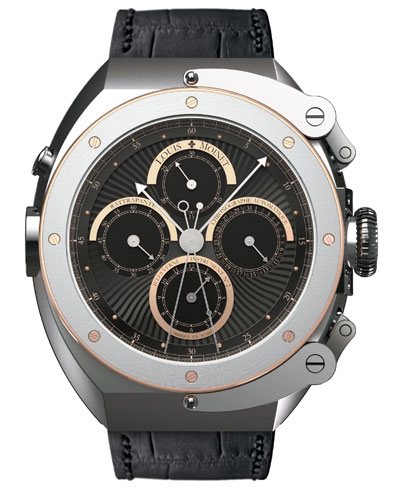
Chronosystem: Hidden Secret no 1: new conception to activate the chronograph function (patent pending) consisting of a lever system set in two positions : armed and disarmed
Porthole: Hidden Secret no 2: featuring a real piece of the moon (lunar meteorite Dhofar 459)
Movement: exclusive self-winding mechanical
Decoration Blued steel screws, oscillating weight decorated with “Côtes du Jura” ® motif
Functions Hour, minute and seconds
60-second chronograph (centre)
30-minute chronograph counter (at 12 o'clock)
12-hour chronograph counter (at 6 o'clock)
Date by hand (at 3 o'clock)
Rattrapante split-second hand (centre)
Jewels 25
Winding Automatic
Oscillations 28,800 vph
Frequency 4 Hz
Balance wheel Glucydur type
Power reserve: 44 hours
Case: Hidden Secret no 4: Titanium Grade 5 & 316l stainless steel & 18K rose gold 5n.
The most useful properties of titanium are the corrosionresistance and lightness. Titanium is ca. 45% lighter than steel
Case diameter: 46.30 mm width x 54 mm length
Case thickness: 14.50 mm
Crown guard: Patent Pending
Water-resistance: 50 metres
Caseback secured with 4 screws, engraved with individual number and louis Moinet emblems
Crystals: Two anti-glare sapphire crystals
Dial: Decorated with “Côtes du Jura” and applied half-circles
Hands: Rhodium-plated and galvanic blue
Strap: Crocodile leather, hand-sewn, “carbon” fi nish
Width: between lugs 24 mm
Buckle: 316l stainless steel folding clasp with louis Moinet symbol
Watch box: Louis Moinet Book in leather, hand-written warranty
JULES VERNE - Instrument 2
Split-Second Chronograph
“A stunning silver collection plate that the celestial powers send spinning through the fi rmament, and which receives a showered offering of stars”
Jules Verne
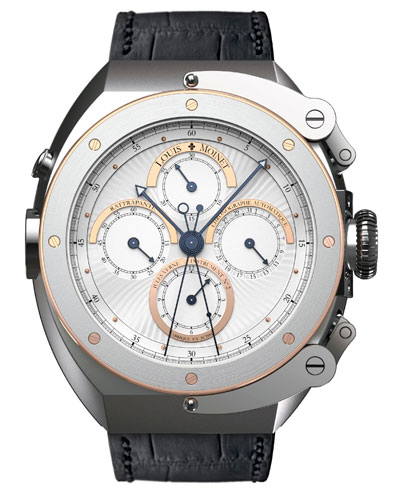
lMV-18.10.60
silver dial
limited edition of 60 watches
Jules Verne & Louis Moinet
Jules Verne's inspiration
Jules Verne (1828-1905) was widely travelled, readily inclined to be fanciful, and above all a true writer who is among the world's most translated authors. Jules Verne's plan was to “depict the whole earth”. To achieve this, he had to contemplate all the knowledge of his day. Moving through a century of changes for which he became the ideal spokesman, he followed a specifi c programme for modern mankind's appropriation of the space that surrounds it.
How can one explain his impact on scientists, authors, adventurers… and even just plain readers of all ages? Probably by his gift of fi lling our hearts with the desire to set out and come to grips with the world's last secrets! Who has not dreamed of treading the soil of an unknown land? Of encountering creatures from the dawn of earth's history? Of travelling around the world on a simple bet and meeting a soul mate along the way? Of going off to conquer the Moon? Who has not imagined himself as Captain nemo standing on the nautilus' bridge, gazing into infi nity, sextant in hand?... All while sitting at home with a book!
Following in Jules Verne's footsteps is not merely paying homage to an extraordinary storyteller; it also means being inspired by his thirst for discovery and his tremendous intellectual ambition.
Jules Verne And Louis Moinet
Did Jules Verne and louis Moinet know each other ? It might well have been the case ! Jules Verne the author and louis Moinet, possibly the most artistic of all watchmakers, certainly had much in common. They lived in Paris, in the middle of the 19th century, and were both passionate about theatre and technical developments. This has been our inspiration to create an extremely high-tech watch line based on a proud heritage.
Jules Verne
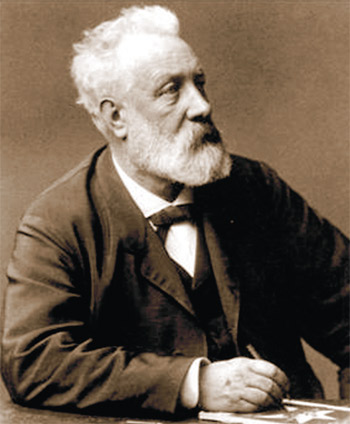
Did the inspired master watchmaker and the science fiction writer ever meet? That is the enigma we decided to solve in our own way, along with Jean-Marie Schaller. Jules Verne passed away in 1905, Louis Moinet in 1853. They shared a passion for innovation. And even if they did not meet, they had every reason to do so. With one mastering time and the other taming science, all for the good of mankind, in this case watchmaking and writing have something in common: accuracy. The sophistication of the movements used in Louis Moinet's systems, and the wealth of detail and extreme credibility mingled with poetry found in my illustrious ancestor's narratives, which were based on the scientific discoveries of his day, bring the two realms astonishingly close together. It is obvious that Jules Verne's work plays constantly with time and space. Several of his works of science fiction were to leave their mark on the history of literature: Twenty Thousand Leagues Under the Sea, From the Earth to the Moon, Robur the Conqueror… These were nothing more than the accurate calculations and predictive vision of science projected into the future.
One obstacle remained: time. Around the World in Eighty Days captured that challenge, won by the man searching for a form of eternity. And I'll give you a scoop: Phileas Fogg travelled with a Louis Moinet.
Jean-Michel Verne
Journalist and writer
Jules Verne and timeYou wear a watch. Does it make you feel that you are in control of time? Or does it not rather make you feel the opposite… that you are always chasing after time… lost…?
Jules Verne asked himself the same question. What was his answer? I leave it for you to discover by reading a short story first published in a magazine in 1854, then again in a book in 1874. The title is Master Zacharius and the story is set in Geneva, Switzerland. Master Zacharius is a watchmaker, the best there is. Gradually, as the story unfolds, he starts to suppose that he controls time. I will leave you the pleasure of discovering what happens to someone who wants to show that he is God's equal…
From the Moon to the Earth
JULES VERNE – DHOFAR 459
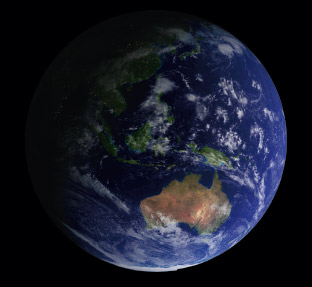
A world first by Louis Moinet – A real piece of the moon! Dhofar 459 is a lunar meteorite that was ejected from the moon 2,000 years ago. The meteorite, which has been authenticated by the university of California, actually added to our knowledge of lunar geology, since it came from a place that the Apollo missions did not visit. Moon stone is an extremely rare material that is even more expensive than gold and platinum combined.
A travel from the Moon to the Earth
500 millions years ago, a fi rst asteroid impacted the Moon. Then, a second asteroid impacted the moon at the same place, circa 2,000 years ago, giving birth to Dhofar 459. Dhofar 459 was accelerated by this asteroidal impact and escaped the Moon's gravitational infl uence. After a journey of unknown duration, it became captured by the earth's gravitational fi eld and eventually landed on earth, in the Desert of Dhofar (sultanate of Oman).
How do we know that it comes from the Moon ?
Dhofar 459 has been analysed and classifi ed by A. rubin and Paul Warren, Institute of Geophysics and Planetary Physics, university of California, los Angeles. of any other type of meteorite or terrestrial rock. Chemical compositions, isotope ratios, minerals, and textures of the lunar meteorites are similar to those of samples collected on the Moon during the Apollo missions. Taken together, these various characteristics are diff erent from those of any other type of meteorite or terrestrial rock.
What is a Lunar Meteorite?
Lunar meteorites are meteorites from the Moon. In other words, they are rocks found on earth that were ejected from the Moon by the impact of an asteroid or possibly a comet. After orbiting the moon for a long time, they were eventually captured by earth's gravitational fi eld, and fell to earth as solid objects. Lunar meteorites are exceedingly rare nearly all meteorites are pieces of asteroids. Only a few rare meteorites come from the Moon.

Featured brand






